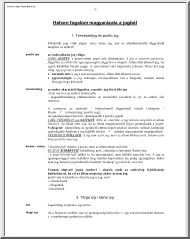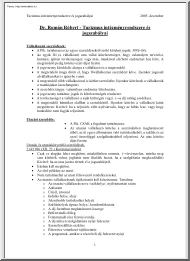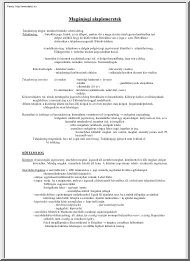Datasheet
Year, pagecount:2019, 4 page(s)
Language:English
Downloads:2
Uploaded:May 06, 2019
Size:552 KB
Institution:
-
Comments:
Colorado Attorney General?s Office
Attachment:-
Download in PDF:Please log in!
Comments
No comments yet. You can be the first!Most popular documents in this category
Content extract
Source: http://www.doksinet PRESS RELEASE January 3, 2019 AG Coffman, Public Health Officials Release Multi-Layered Study to Address Alarming Youth Suicide Trends Across Colorado Study focused on counties with highest youth suicide rate DENVERToday Colorado Attorney General Cynthia H. Coffman announced the release of a qualitative study Community Conversations to Inform Youth Suicide Prevention, which analyzes and characterizes the trends and patterns in the fatal and non-fatal suicidal behaviors among young people in the four Colorado counties with the highest rates of youth suicide: El Paso, La Plata, Mesa, and Pueblo. The purpose of the study is to determine the best strategies for addressing and preventing youth suicide in Colorado and to see where the state’s efforts and dollars can be used most effectively. The study was funded with $173,000 from the Attorney General’s Office and was conducted by Health Management Associates (HMA). A full copy of the report can be found at:
https://coag.gov/sites/default/files/final youth suicide in colorado report 100118pdf “Suicide is a public health crisis and too many families in our state have faced the loss of a loved one due to death by suicide,” said Attorney General Coffman. “We know that we have many young people in our state who are struggling, and my hope is that this study will shed light on the very real impact of suicide loss and help to provide coordinated and comprehensive prevention efforts going forward. We have incredible people in our state working hard to help prevent suicide, and in particular I am so grateful to the dedicated people from the four counties who were willing to participate in this study. These are true heroes who are often doing so much with so little to try and save the lives of people in crisis.” Key partners in this effort include the Office of Suicide Prevention at the Colorado Department of Public Health and Environment (CDPHE), local public health agencies, school
districts and community mental health agencies in each of the four counties. “The comprehensive study completed by the Attorney General’s Office provides valuable data as well as public feedback that will inform the community-based process in place to address suicide prevention in La Plata County,” Source: http://www.doksinet said Liane Jollon, San Juan Basin Public Health Executive Director. “The issue of suicide prevention is a critical one in our region and any insight provided on gaps, needs, and strategies will only help to strengthen collaborative efforts to build resilience in the communities we serve.” HMA designed a multi-pronged strategy to the study with the goal of learning about opportunities and approaches to youth suicide prevention in each of the four counties, and across Colorado. Central to the study was the concept of community conversations. “This study highlights the need for opportunities to build a sense of social connection, which is incredibly
validating as we’re using upstream approaches and inter-agency collaboration to increase opportunities for youth and adults to come together in healthy, pro-social ways in Mesa County,” said Jeff Kuhr, Executive Director of the Mesa County Health Department. The project team conducted 42-stakeholder interviews with representatives from public health, behavioral health, schools and youth serving organizations. The team also facilitated 34 focus groups with adults and youth from various communities and sectors. For comparison, focus groups were conducted with school staff and parents in Douglas and Larimer counties, where youth suicide rates were lower and/or there had not been recent suicide clusters. “We are grateful to our state partners for responding to our urgent call for additional county level research on this important and heart wrenching topic,” said Susan Wheelan, MBA, Public Health Director El Paso County Public Health. “The findings in the report affirm that mental
health and wellness are important to our community and youth suicide prevention is a shared priority. Since 2015, El Paso County Public Health has convened multisector community partners to take collective action through the Youth Suicide Prevention Workgroup and the Child Fatality Review Team. We commend our community’s early accomplishments in addressing this complex issue, recognize the need to remain vigilant, and aim to strengthen our targeted approach with the report’s findings.” HMA also reviewed information on current suicide prevention activities and resources in the four counties and across Colorado, reviewed traditional and social media coverage related to suicide in the four counties and the state, and reviewed publicly available information on school policies and procedures related to suicide prevention and postvention in the aftermath of a student suicide or suicide attempt. Source: http://www.doksinet “As a result of the youth suicide rate, community
organizations in Pueblo have taken steps to increase access to mental health care, train providers and other professionals to take mental health as seriously as physical health, reduce stigma among youth about seeking help, and improve positive youth development,” said Colter DeWitt, Health Promotion Specialist, Pueblo Department of Public Health & Environment. “This report will help to further guide our efforts and supplement work the Pueblo community is already doing by closing gaps and coordinating strategies and programs statewide.” Key findings: Risk factors attributing to youth suicide: • Pressure and anxiety about failing. • Social media and cyber bullying. • Lack of prosocial activities. • Lack of connection to a caring adult. • Judgement and lack of acceptance in the community. • Substance use, mental health disorders and trauma history. • Adult suicides in the community impact youth. Barriers to suicide prevention: • Not enough resources to
effectively implement youth suicide prevention, intervention and postvention activities. • Each county faces lack of resources and funding for public health and social services programs. • Lack of equitable distribution of resources across agencies. • Lack of mental health providers in these communities who accept Medicaid. • Communities with more mental health resources have few providers who are trained to work with youth or the providers only accept adults. • Stigma associated with seeking help. • Stigma against LGBTQ+ individuals limits the places and resources from which those individuals seek help. “This document will be extremely useful in our suicide prevention work,” Melanie Voegeli-Morris, Poudre School District Mental Health and Prevention Coordinator. “The ‘Looking Ahead Recommendations’ can be used at all Source: http://www.doksinet levels in our district. So good to have the state statistics to help inform our district on the scope and impact of
suicide as well as recommendations of actions that we can implement in our prevention work.” Colorado consistently ranks in the top ten states with the highest suicide rate. More Coloradans die by suicide than by homicide, motor vehicle crash, diabetes, and breast cancer, and it is the 2nd leading cause of death for those ages 10-34. The Attorney General’s Office oversees the statewide Safe2Tell program. Safe2Tell is a very successful and effective anonymous bystander reporting program where any concerned individual can make a report by phone, on the computer or via the mobile application when they fear for their safety or the safety of others, in schools or in communities. Children’s lives across Colorado have been saved because someone was concerned about them and had the courage to speak up and report that information to Safe2Tell. Youth are using Safe2Tell, which allows them to alert authorities when they believe someone may need help. For the past four years, reports related
to youth suicide intervention have been the number one type of tip received by Safe2Tell. In the 2016-2017 school year, there were 1,742 suicide intervention tips. That number grew substantially in the 2017-2018 school year, with Safe2Tell receiving 2,786 suicide intervention tips. For more information about the Safe2Tell program go to https://safe2tell.org/ * Press contacts for participants from the additional counties are available. Please contact Annie Skinner for assistance* ### CONTACT Annie Skinner Colorado Attorney General’s Office 720-508-6553 or Annie.skinner@coaggov
https://coag.gov/sites/default/files/final youth suicide in colorado report 100118pdf “Suicide is a public health crisis and too many families in our state have faced the loss of a loved one due to death by suicide,” said Attorney General Coffman. “We know that we have many young people in our state who are struggling, and my hope is that this study will shed light on the very real impact of suicide loss and help to provide coordinated and comprehensive prevention efforts going forward. We have incredible people in our state working hard to help prevent suicide, and in particular I am so grateful to the dedicated people from the four counties who were willing to participate in this study. These are true heroes who are often doing so much with so little to try and save the lives of people in crisis.” Key partners in this effort include the Office of Suicide Prevention at the Colorado Department of Public Health and Environment (CDPHE), local public health agencies, school
districts and community mental health agencies in each of the four counties. “The comprehensive study completed by the Attorney General’s Office provides valuable data as well as public feedback that will inform the community-based process in place to address suicide prevention in La Plata County,” Source: http://www.doksinet said Liane Jollon, San Juan Basin Public Health Executive Director. “The issue of suicide prevention is a critical one in our region and any insight provided on gaps, needs, and strategies will only help to strengthen collaborative efforts to build resilience in the communities we serve.” HMA designed a multi-pronged strategy to the study with the goal of learning about opportunities and approaches to youth suicide prevention in each of the four counties, and across Colorado. Central to the study was the concept of community conversations. “This study highlights the need for opportunities to build a sense of social connection, which is incredibly
validating as we’re using upstream approaches and inter-agency collaboration to increase opportunities for youth and adults to come together in healthy, pro-social ways in Mesa County,” said Jeff Kuhr, Executive Director of the Mesa County Health Department. The project team conducted 42-stakeholder interviews with representatives from public health, behavioral health, schools and youth serving organizations. The team also facilitated 34 focus groups with adults and youth from various communities and sectors. For comparison, focus groups were conducted with school staff and parents in Douglas and Larimer counties, where youth suicide rates were lower and/or there had not been recent suicide clusters. “We are grateful to our state partners for responding to our urgent call for additional county level research on this important and heart wrenching topic,” said Susan Wheelan, MBA, Public Health Director El Paso County Public Health. “The findings in the report affirm that mental
health and wellness are important to our community and youth suicide prevention is a shared priority. Since 2015, El Paso County Public Health has convened multisector community partners to take collective action through the Youth Suicide Prevention Workgroup and the Child Fatality Review Team. We commend our community’s early accomplishments in addressing this complex issue, recognize the need to remain vigilant, and aim to strengthen our targeted approach with the report’s findings.” HMA also reviewed information on current suicide prevention activities and resources in the four counties and across Colorado, reviewed traditional and social media coverage related to suicide in the four counties and the state, and reviewed publicly available information on school policies and procedures related to suicide prevention and postvention in the aftermath of a student suicide or suicide attempt. Source: http://www.doksinet “As a result of the youth suicide rate, community
organizations in Pueblo have taken steps to increase access to mental health care, train providers and other professionals to take mental health as seriously as physical health, reduce stigma among youth about seeking help, and improve positive youth development,” said Colter DeWitt, Health Promotion Specialist, Pueblo Department of Public Health & Environment. “This report will help to further guide our efforts and supplement work the Pueblo community is already doing by closing gaps and coordinating strategies and programs statewide.” Key findings: Risk factors attributing to youth suicide: • Pressure and anxiety about failing. • Social media and cyber bullying. • Lack of prosocial activities. • Lack of connection to a caring adult. • Judgement and lack of acceptance in the community. • Substance use, mental health disorders and trauma history. • Adult suicides in the community impact youth. Barriers to suicide prevention: • Not enough resources to
effectively implement youth suicide prevention, intervention and postvention activities. • Each county faces lack of resources and funding for public health and social services programs. • Lack of equitable distribution of resources across agencies. • Lack of mental health providers in these communities who accept Medicaid. • Communities with more mental health resources have few providers who are trained to work with youth or the providers only accept adults. • Stigma associated with seeking help. • Stigma against LGBTQ+ individuals limits the places and resources from which those individuals seek help. “This document will be extremely useful in our suicide prevention work,” Melanie Voegeli-Morris, Poudre School District Mental Health and Prevention Coordinator. “The ‘Looking Ahead Recommendations’ can be used at all Source: http://www.doksinet levels in our district. So good to have the state statistics to help inform our district on the scope and impact of
suicide as well as recommendations of actions that we can implement in our prevention work.” Colorado consistently ranks in the top ten states with the highest suicide rate. More Coloradans die by suicide than by homicide, motor vehicle crash, diabetes, and breast cancer, and it is the 2nd leading cause of death for those ages 10-34. The Attorney General’s Office oversees the statewide Safe2Tell program. Safe2Tell is a very successful and effective anonymous bystander reporting program where any concerned individual can make a report by phone, on the computer or via the mobile application when they fear for their safety or the safety of others, in schools or in communities. Children’s lives across Colorado have been saved because someone was concerned about them and had the courage to speak up and report that information to Safe2Tell. Youth are using Safe2Tell, which allows them to alert authorities when they believe someone may need help. For the past four years, reports related
to youth suicide intervention have been the number one type of tip received by Safe2Tell. In the 2016-2017 school year, there were 1,742 suicide intervention tips. That number grew substantially in the 2017-2018 school year, with Safe2Tell receiving 2,786 suicide intervention tips. For more information about the Safe2Tell program go to https://safe2tell.org/ * Press contacts for participants from the additional counties are available. Please contact Annie Skinner for assistance* ### CONTACT Annie Skinner Colorado Attorney General’s Office 720-508-6553 or Annie.skinner@coaggov





 Just like you draw up a plan when you’re going to war, building a house, or even going on vacation, you need to draw up a plan for your business. This tutorial will help you to clearly see where you are and make it possible to understand where you’re going.
Just like you draw up a plan when you’re going to war, building a house, or even going on vacation, you need to draw up a plan for your business. This tutorial will help you to clearly see where you are and make it possible to understand where you’re going.